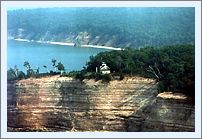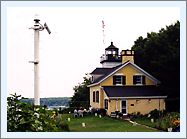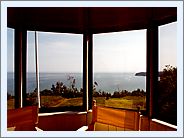|
Historical Information

Eight miles in length, and
three miles in width, Grand Island is the largest island on Superior's
south shore. Long known by fur traders for the natural harbor of refuge
on the island's southern lee, the North West Company established a post
on the site of present day Munising in the late 1700's, and subsequently
the American Fur Company operated a post on the Island itself during the
early decades of the nineteenth century. The hay days of "King
Fur" were fading into memory when Abraham Williams, the island's
first permanent white settler arrived from Vermont in 1837 and set up
homesteading in a couple of the old abandoned trading post buildings on
the island's south shore. As other settlers began arriving to eke an
existence from the island's shores, Williams established a trading post,
blacksmith's shop and sawmill on the island. As well as serving the
needs if the growing island community, Williams also began selling
cordwood to steamers seeking refuge in the shelter of the island.
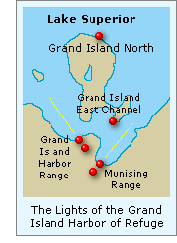 With construction of the new lock at
the Soo planned for completion in 1855, a major boom in maritime
commerce on Lake Superior was both expected and eagerly anticipated.
With Grand Island representing both a turning point for vessels coasting
the south shore and the only natural harbor of refuge between the Soo
and Marquette, the call went up in the maritime community to place a
Light on Grand Island in order to serve the needs of maritime commerce. With construction of the new lock at
the Soo planned for completion in 1855, a major boom in maritime
commerce on Lake Superior was both expected and eagerly anticipated.
With Grand Island representing both a turning point for vessels coasting
the south shore and the only natural harbor of refuge between the Soo
and Marquette, the call went up in the maritime community to place a
Light on Grand Island in order to serve the needs of maritime commerce.
Congress appropriated $5,000 for
building the lighthouse on the island on March 3, 1853. A site was
selected at the northern end of the island, and a lease for the property
obtained from the State of Michigan. Situated at the top of a 175-foot
cliff, the site was considered ideal, since at that height and location
it would be visible for the greatest distance to both east and
west-bound vessels. As was the case at that time with most light
stations built such a distance from the depot, frequent use was made of
local materials in order to minimize costs through the elimination of
long distance transportation. This was of particular importance in the
building of early Lights on Superior, since in the days before the Soo
lock, any materials shipped from the lower lakes would have to be
unloaded at the lower end of the rapids, loaded onto carts and
transported around the rapids to be reloaded into a second vessel at the
head of the rapids for further shipment across Superior to the selected
building site.
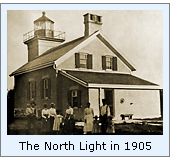 We have thus far been unable to
identify the specific design and materials used in building this
station, however all indications are that the building that took shape
on Grand Island over 1856 was likely a timber framed structure with a
short tower integrated into the roof. The tower was likely capped with a
prefabricated cast iron lantern, which along with the illuminating
apparatus would have constituted the only two major components shipped
to the station from Detroit. The station's Fourth Order Fresnel
lens was
manufactured by L. Sautter of Paris, and was designed to show a constant
white light varied by bright flashes. To achieve these flashes, the lens
was installed on a rotating pedestal incorporating a clockwork
mechanism, which rotated the lens around the lamp. When the bulls-eye
panels on the surface of the lens passed between the lens and the
observer, the light would be thus magnified, and appear as a bright
flash. Installed 32 feet above the tower foundation, the liens stood at
a focal plane of 204 feet above the surface of the lake, and was visible
to mariners at a distance of 13 miles in clear weather. While the exact
date of the light's initial exhibition has yet to be determined, we do
know that the station was put into service at some time during 1856. We have thus far been unable to
identify the specific design and materials used in building this
station, however all indications are that the building that took shape
on Grand Island over 1856 was likely a timber framed structure with a
short tower integrated into the roof. The tower was likely capped with a
prefabricated cast iron lantern, which along with the illuminating
apparatus would have constituted the only two major components shipped
to the station from Detroit. The station's Fourth Order Fresnel
lens was
manufactured by L. Sautter of Paris, and was designed to show a constant
white light varied by bright flashes. To achieve these flashes, the lens
was installed on a rotating pedestal incorporating a clockwork
mechanism, which rotated the lens around the lamp. When the bulls-eye
panels on the surface of the lens passed between the lens and the
observer, the light would be thus magnified, and appear as a bright
flash. Installed 32 feet above the tower foundation, the liens stood at
a focal plane of 204 feet above the surface of the lake, and was visible
to mariners at a distance of 13 miles in clear weather. While the exact
date of the light's initial exhibition has yet to be determined, we do
know that the station was put into service at some time during 1856.
 As a result of the station's location
atop the sheer cliff, it was impossible to locate the station's
boathouse and landing close by, and the boathouse was this built in a
bay approximately 1/4 mile to the southeast of the station. The terrain between the two, which was laced
with ravines and gullies made the going difficult under the best of
conditions. To rectify the situation, a series of walkways with a
built-in tram were constructed along the half-mile trail in 1860.
Consisting of timber trestles with a plank surface, the walkway included
four bridges of between 25 and 70 feet in length, and was no doubt an
improvement welcomed by the station's keeper. As a result of the station's location
atop the sheer cliff, it was impossible to locate the station's
boathouse and landing close by, and the boathouse was this built in a
bay approximately 1/4 mile to the southeast of the station. The terrain between the two, which was laced
with ravines and gullies made the going difficult under the best of
conditions. To rectify the situation, a series of walkways with a
built-in tram were constructed along the half-mile trail in 1860.
Consisting of timber trestles with a plank surface, the walkway included
four bridges of between 25 and 70 feet in length, and was no doubt an
improvement welcomed by the station's keeper.
After only ten years, the condition of
the station deteriorated dramatically, and in his 1865 annual inspection
of the station, the Eleventh District Inspector state that he found the
buildings to be in a "wretched condition on account of inferior
materials used in its construction." Observing that the situation
had already passed the point at which any repair would be effectual, he
recommended that the only viable solution was that the entire structure
be completely demolished and a new station be built in its place.
Congress responded quickly, appropriating $12,000 for the station's
replacement the following year.
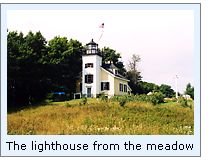 A work crew returned to Grand Island in
1867, this time bringing with them all of the construction materials
required for the complete rebuilding of a more substantial station.
Since brick was chosen as the primary building material, one can only
imagine the difficulty encountered by the crew in transporting the tons
of materials from the boat landing at the foot of the cliff and up the
walkway to the construction site. With ten other stations being either
established or rebuilt at this same time, all eleven were built to the
same plan. Consisting a of a simple 1 ½ -story brick keepers dwelling
with an attached 40 foot tall square tower at one of the gable ends, the
design has come to be known as the "schoolhouse style" over
the ensuing years, as a result of the similarity in appearance to the
one-room schoolhouses that were built throughout the country in the late
1800's. With the Fresnel transferred from the old tower, the District
Inspector reported that the lighthouse "is now in excellent
condition," and it was officially placed into service in 1867. A work crew returned to Grand Island in
1867, this time bringing with them all of the construction materials
required for the complete rebuilding of a more substantial station.
Since brick was chosen as the primary building material, one can only
imagine the difficulty encountered by the crew in transporting the tons
of materials from the boat landing at the foot of the cliff and up the
walkway to the construction site. With ten other stations being either
established or rebuilt at this same time, all eleven were built to the
same plan. Consisting a of a simple 1 ½ -story brick keepers dwelling
with an attached 40 foot tall square tower at one of the gable ends, the
design has come to be known as the "schoolhouse style" over
the ensuing years, as a result of the similarity in appearance to the
one-room schoolhouses that were built throughout the country in the late
1800's. With the Fresnel transferred from the old tower, the District
Inspector reported that the lighthouse "is now in excellent
condition," and it was officially placed into service in 1867.
The importance placed upon this station
was witnessed by the fact the Lighthouse Board recommended the
installation of a fog signal at Grand Island North in 1882. However, funds
were never appropriated and the matter was abandoned.
1885 saw 229 feet of the stairs and tramway rebuilt, and the extension
of the boat ways at the shore to allow the boat to be launched and
retrieved more readily.
 Over the years, Abraham Williams and
his family had purchased large tracts of the island from the State of
Michigan, and in order to protect the lighthouse reservation, Congress
appropriated the necessary funds to purchase the property from the State
on March 3, 1887. By 1896, the Williams family owned almost the entire
island, and receiving an "offer they could not refuse" decided
to sell their island holdings to the Cleveland Cliffs Company for the
sum of $93,701.61. Cleveland Cliffs was the first major company to tap
Superior's mineral wealth, having begun mining the Marquette Range in
1850. Incredibly successful, the company purchased the land from the
Williams' in order to create a vacation and hunting paradise. Over the
ensuing years, the company built a number of vacation cabins, and
groomed horse trails led through the woods of the island, which had been
stocked with moose, caribou and antelope for the hunting pleasure of
company executives and their guests. Over the years, Abraham Williams and
his family had purchased large tracts of the island from the State of
Michigan, and in order to protect the lighthouse reservation, Congress
appropriated the necessary funds to purchase the property from the State
on March 3, 1887. By 1896, the Williams family owned almost the entire
island, and receiving an "offer they could not refuse" decided
to sell their island holdings to the Cleveland Cliffs Company for the
sum of $93,701.61. Cleveland Cliffs was the first major company to tap
Superior's mineral wealth, having begun mining the Marquette Range in
1850. Incredibly successful, the company purchased the land from the
Williams' in order to create a vacation and hunting paradise. Over the
ensuing years, the company built a number of vacation cabins, and
groomed horse trails led through the woods of the island, which had been
stocked with moose, caribou and antelope for the hunting pleasure of
company executives and their guests.
 Realizing that almost 400 acres of the
original lighthouse reservation remained as yet unused, the Lighthouse
Board seized the opportunity to liquidate the excess property, selling
it to Cleveland Cliffs at public auction in Munising on June 10, 1901.
As a result, the lighthouse reservation was reduced to the cleared area
in the immediate proximity of the station, with the station's boathouse
now located beyond the new property lines. That same year, the boat
house was moved 190 feet westward, and a completely new stone-filled
timber boat dock built at the new location. Realizing that almost 400 acres of the
original lighthouse reservation remained as yet unused, the Lighthouse
Board seized the opportunity to liquidate the excess property, selling
it to Cleveland Cliffs at public auction in Munising on June 10, 1901.
As a result, the lighthouse reservation was reduced to the cleared area
in the immediate proximity of the station, with the station's boathouse
now located beyond the new property lines. That same year, the boat
house was moved 190 feet westward, and a completely new stone-filled
timber boat dock built at the new location.
With the Coast Guard's assumption of
responsibility for the nation's aids to navigation in 1939, the
overextended office began experimenting with various automation schemes
in order to reduce manpower and operating costs. Particular success was
found in the use of acetylene, with the light automatically controlled
by a sun valve. Such a system was installed at Grand Island in 1941, and
with the keeper no longer required to tend the light, the station was
boarded-up and abandoned, save for infrequent trips by Coast Guard crews
to check the equipment and refill the acetylene tank. Without constant
maintenance provided by the keeper, the buildings inevitably began to
deteriorate.
 By the late 1950's, solar powered
electrical technology had advanced to the point that small direct
current photovoltaic systems were becoming available. Equipped with
automatic bulb changers, such systems offered a virtually
maintenance-free solution to lighthouse illumination. In 1961, a 25-foot
steel pole was erected close to the edge of the cliff, with a 12-volt
solar-powered light installed at its uppermost. The old Fresnel lens was
subsequently removed from the tower to protect it from vandalism, and
shipped to an unknown destination for storage or sale. By the late 1950's, solar powered
electrical technology had advanced to the point that small direct
current photovoltaic systems were becoming available. Equipped with
automatic bulb changers, such systems offered a virtually
maintenance-free solution to lighthouse illumination. In 1961, a 25-foot
steel pole was erected close to the edge of the cliff, with a 12-volt
solar-powered light installed at its uppermost. The old Fresnel lens was
subsequently removed from the tower to protect it from vandalism, and
shipped to an unknown destination for storage or sale.
No longer serving any purpose, the
station buildings and property were declared as surplus, and sold to Dr.
Loren Graham, an MIT professor, and author of "A Face in the
Rock," chronicling the rich native heritage of the island. Dr.
Graham's wife Pat has deep-standing family ties to the island, and over subsequent years
the couple have put
a great deal of effort into restoring the station
buildings in order to convert it into a family summer home.
 Today, Grand Island is designated as a
National Recreation Area, indicating that it is considered an area whose
natural beauty and history make it an area uniquely suitable to quiet
recreation and exploration. Passenger ferries make their way across the
bay to the island, where hikers and mountain bike aficionados roam the
scenic but unimproved roads and pathways. Today, Grand Island is designated as a
National Recreation Area, indicating that it is considered an area whose
natural beauty and history make it an area uniquely suitable to quiet
recreation and exploration. Passenger ferries make their way across the
bay to the island, where hikers and mountain bike aficionados roam the
scenic but unimproved roads and pathways.
The Grand Island North Light
reservation remains in the Graham's care, and as private property, visitors are asked to
respect the privacy of the owners, and not to trespass.

Seeing this Light

We
have yet to make the trip out to Grand Island to view this Light,
however we wish to take this opportunity to thank Jeff Shook & Brian
Malone, who have both been fortunate enough to fly over the Light for sharing their photographs with us.

Finding this
Light

Since the Grand Island North Lighthouse is on private property, it
cannot be viewed from land. Also, its location atop the cliff precludes
viewing from the water, leaving views from the air the only possibility.
Pilot Mark Geitka operates Skylane
Pictured Rocks & Grand Island Air Tours out of Munising, and offers
a 45 minute flight includes spectacular views of both the Pictured Rocks
and the Grand Island North Light. Cost of the flight is $90, with the
Cessna 182 holding a total of three passengers.
Contact Skylane at:
P.O. Box 544 Munising, Michigan 49862
Telephone: (906) 222-8367

Reference Sources

Annual reports of the Lighthouse Board, 1865-1908.
Great Lakes Light List, various, 1869 - 1972.
Photographs courtesy of Dr. Loren Graham and Jeff Shook
Personal visit to Grand Island on 08/10/2003
Historical photographs courtesy of the USCG and the Alger County
Historical Society.
1953 Great Lakes Coast Pilot, US Army Corps of Engineers, 1953.
|
